From the Space Station to the COVID Ward
Serena Auñón-Chancellor M.D., Physician and Astronaut, Recounts her Life in Space and Teaching Residents and Taking Care of Patients on the faculty of LSU Health New Orleans School of Medicine
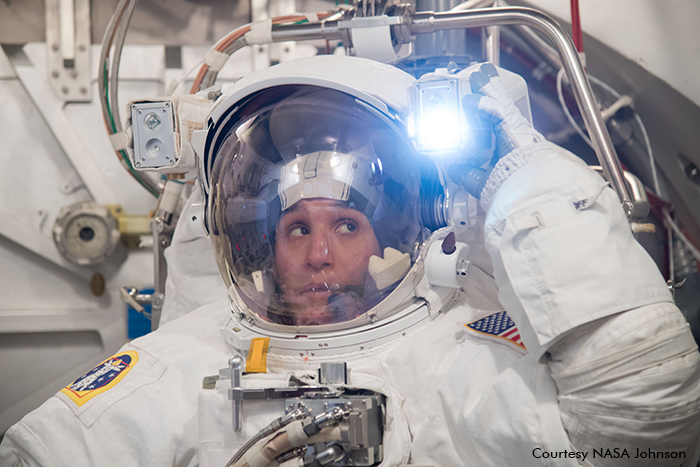
The circumstances were different, but with ties to today. The quarantine she endured was not due to an illness. It was routine before going into space, although COVID-19 pandemic quarantines are part of her world today. Because NASA ceased launching its own spacecraft after the last shuttle mission piloted by astronaut Douglas Hurley in 2011, Dr. Auñón-Chancellor had to fly to Moscow to launch from Baikonur Cosmodrome in Kazakhstan aboard a Soyuz spacecraft headed to the International Space Station.
“It is very different when you don’t launch out of your own country,” Auñón-Chancellor says. “The last time I saw the United States was a good two months prior to our actual launch date as I took off out of Houston to fly to Moscow.”Regardless of where the rocket blasts off, the astronauts share a common mindset.
But even after years of intense training and mission preparation, sitting atop a 300+-ton bomb would give anyone pause, no matter how fleeting. Especially for the first time.
“I think everyone’s a little bit afraid right before those rocket engines light,” admits Dr. Auñón-Chancellor, who was named to the 9-member 20th NASA Astronaut Class in 2009. “I will say, however, that our training is so good and prepares you for just about anything. On launch day, I was stunned at how calm everything was and how calm I felt inside. Once the Soyuz launches, it’s about eight minutes and 40 seconds until you reach orbit. You are so focused on the operation of the vehicle and everything you’re supposed to be monitoring, that the time goes by in an instant. And before you know it, you’re in space.”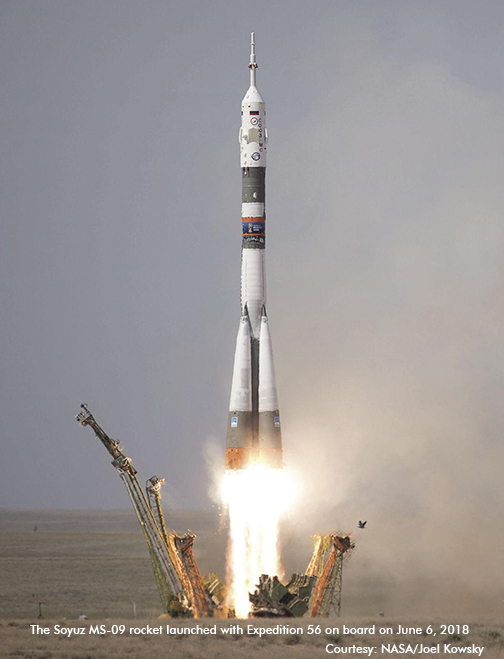
“I think one of the best parts about launch was when the shroud came off of our vehicle,” recalls Auñón-Chancellor. “People don’t realize that we’re actually completely encased inside the rocket as we lift off from the launch pad. We cannot see outside our windows. When that shroud does finally come off… and you see the curvature of the Earth and the beautiful blue… It’s stunning.”
Auñón-Chancellor, who served as Flight Engineer for Expeditions 56 and 57, spent 197 days on the International Space Station (ISS).“I think the biggest adjustment, certainly during the first couple of weeks, is your body adjusting to microgravity,” says Auñón-Chancellor. “You feel it almost immediately when you’re launching. After that eight minutes and 40 seconds when the third stage finally cuts off, your brain does not perceive your environment the same as it did back on Earth. I almost felt like everything was at a 45-degree tilt to the left in front of me, and even the control panels and the console in the Soyuz vehicle itself appeared different. That took a couple of hours to resolve. Many astronauts say when they first launch and reach microgravity, they get something called an inversion illusion, or what they like to term the ‘Spiderman Illusion’ where you feel like you’re hanging upside down.”
Besides fluids suddenly shifting to the head area producing a stuffy, very full feeling, there are other physical effects.“Once you finally arrive on station, you don’t feel great,” Auñón-Chancellor remembers. “Your stomach doesn’t feel great. You don’t eat a whole lot. There’s some nausea there.”
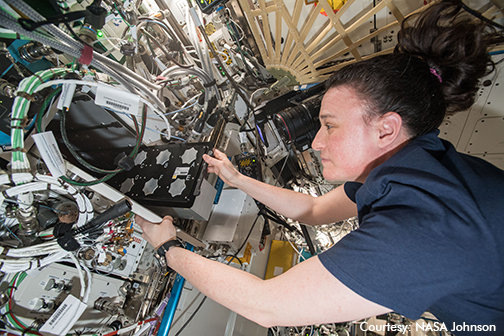
“Remember on ISS, you can operate in 3D meaning there is no up or down really. I mean we have a perceived up and down within the ISS structure and how we line up our laptops. But even with that, I can do science on any side. I can do science on the ceiling. I can do science on the walls. I can be flipped upside down. I can eat upside down. It doesn’t really matter. So, it takes a little while for your brain to get used to that. We kind of call that the first reprogramming phase.”
Auñón-Chancellor explains, “Your brain quickly adapts to this new environment to say ‘Hey you know what? It’s ok if I put myself upside down and then move into another module. I’ve learned how to reconstruct where I am in space, and therefore, I don’t get disoriented.’ You get disoriented a lot during the first week or two, especially on your first flight. You really try to maintain that head being up feet being down attitude, and then by the third or fourth week, and certainly by the first month, you can deftly float and spin and fly and twirl in and out of each module with no concern for what direction, where your feet or pointed, where your head is, you know where you are, and the brain has really adapted beautifully to that. And it was fascinating to watch it myself after hearing about it all those years.”
The days were long and filled with hard work.“Our day would start with what we called a morning DPC—Daily Planning Conference—where we would touch base with every mission control. Not just Houston, but there was Mission Control Moscow, Tsukuba, Japan; Munich, and finally Huntsville, Alabama because they ran a lot of our science,” notes Auñón-Chancellor.
That was at about 7:15 a.m., and they worked until about 7 p.m. Although every minute of every day was filled with activity, the majority of the day was spent doing science.NASA reports that her 56 and 57 crews contributed to hundreds of experiments in biology, biotechnology, physical science and Earth science aboard the International Space Station. Investigations were led into new cancer treatment methods and algae growth in space. They also installed a new Life Sciences Glovebox, a sealed work area for life science and technology investigations that can accommodate two astronauts.
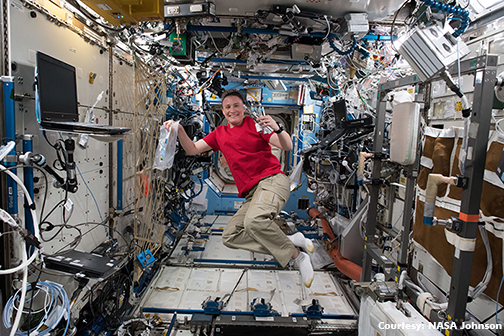
“It’s very important to maintain fitness while you’re up there and also to stave off bone mineral density loss and also muscle mass loss, and we did that by working out every day for two and a half hours,” says Auñón-Chancellor. “That included an hour of aerobic activity and an hour and a half on our ‘weight machine’. It’s actually called an ARED – Advanced Resistive Exercise Device. By using vacuum tubes, you can generate load, so that’s how we would lift.”
Auñón-Chancellor’s most memorable experiences ranged from the magnificently exquisite to the movingly deep.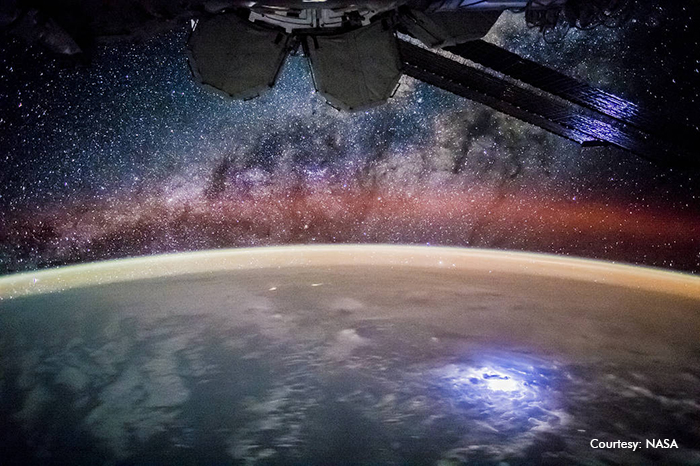
What she missed most besides her family, was unexpected yet achingly profound.
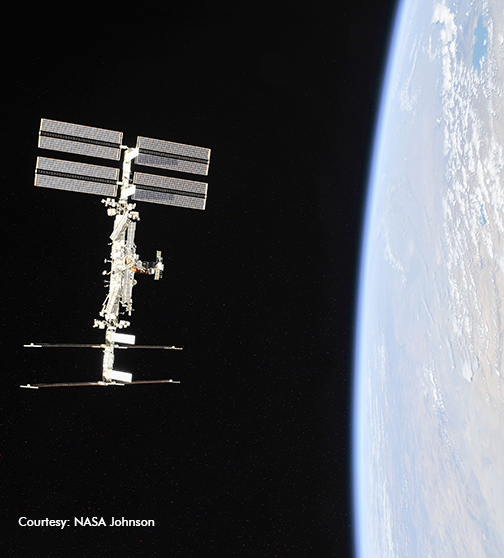
“I’m one of the academic clinical faculty as part of the Internal Medicine Residency Program here at LSU Health New Orleans medical school branch campus,” states Auñón-Chancellor, who is board certified in Internal and Aerospace Medicine. “I’m doing absolutely one of my favorite things, which is teaching residents and medical students. I’m super excited to be here. Being academic medicine faculty is one of the most, if not the most important. things to me. I love being part of the critical years of a residency program where I get to take part in the shaping and molding of young physicians. The right faculty and the right mentor can really make all the difference, and that’s what I wanted to return to.”
Her husband was being heavily recruited by the Department of Physics at LSU while Auñón-Chancellor was still on the space station. A lot of his research deals with space radiation and clinical outcomes, so “we’re both kind of in the space business.” Her only requirement for moving to Baton Rouge was the existence of an Internal Medicine residency program. Enter Dr Steve Nelson, Dean of LSU Health New Orleans School of Medicine. Internal Medicine is only one of the residency programs at the School’s Baton Rouge branch campus. He felt that Auñón-Chancellor would be an excellent addition to his faculty there.“Dr. Auñón-Chancellor is an exceptional physician and teacher – reasons enough to recruit her,” Dr. Nelson says. “But we also hope to build an aerospace medicine program around the breadth and scope of her knowledge.”
“The people are fantastic,” she says. “I’ve really enjoyed getting to know them. I feel like I fit right in. I feel like it’s my family, and I belong here.”Besides teaching, it also got her back to patient care. She loves it so much, she resumed taking care of patients about six weeks after her return to Earth—after she learned how to walk again and could handle a 12-hour shift again.
“I love taking care of patients, whether they’re a little bit sick or a lot sick,” says Auñón-Chancellor.Lately she has been taking care of those a lot sick -- with COVID-19.

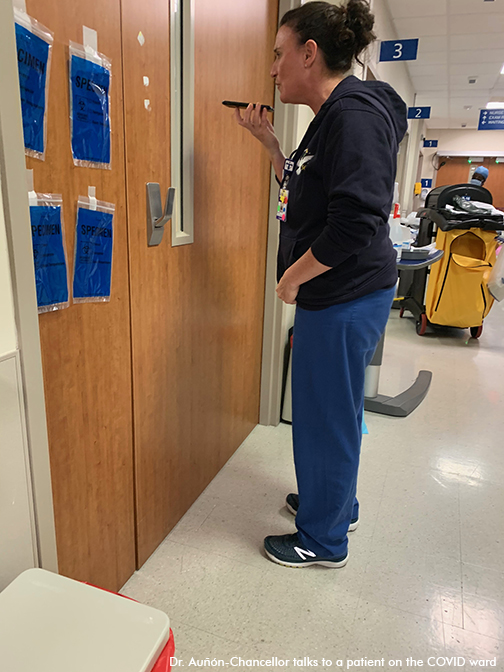
“I still work in the NASA Astronaut Office, and I spend a good portion of my time covering medical issues with other astronaut physicians. That can be for the Space Station, for our commercial crew vehicles like this latest launch. It can be for lunar habitats because we are going back to the moon. It can be for exploration class missions to Mars. It just depends on the day, what problem we’re facing. But one of our limiting factors, certainly heading towards Mars or even back to the moon is the human – protecting the human, understanding how the human changes in microgravity and how do we provide for and protect the human during those long journeys, so that’s what I’m working on now.”
The new-era launch holds special significance for Auñón-Chancellor.“I actually know Doug Hurley and Bob Behnken pretty well."
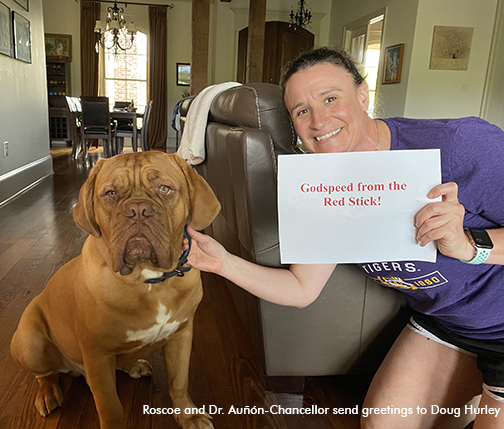
Hurley’s and Behnken’s SpaceX Crew Dragon mission holds great significance for the rest of us, too.
“One of the biggest reasons why this commercial crew launch from Cape Canaveral, Florida is so important is because you have to realize what capability it gives us on board the ISS. And people say, ‘Well that’s great doc, you know, you can do your work up there, it doesn’t really matter to me.’ What people have to understand is that the majority of science we do up there, especially life science, I’d say a good 70 – 75%, is for people back here on Earth. It doesn’t help me get to Mars. It doesn’t help other astronauts get to the moon. It is research we are doing up there to help treat cancer, to help with particular drugs that treat cancer. To help find better treatments for Parkinson’s Disease. To look at how muscles atrophy in our elderly population and how do we stave that off. To help develop better retinal implants for people with macular degeneration. I can go on and on and on, but the life science research that we do on board the space station is for everyone’s health down here. And we cannot stop that, and we have to push forward. So why is this commercial crew launch so important? Because now, we have the capability to launch ourselves. Now we’ll still be launching with the Russians, but also to launch ourselves out of Florida and bring even more people to the space station to get that science done. That’s what’s important -- the more woman power and manpower that we have on orbit, the more science we can do for you to protect you and your health back here on Earth.”